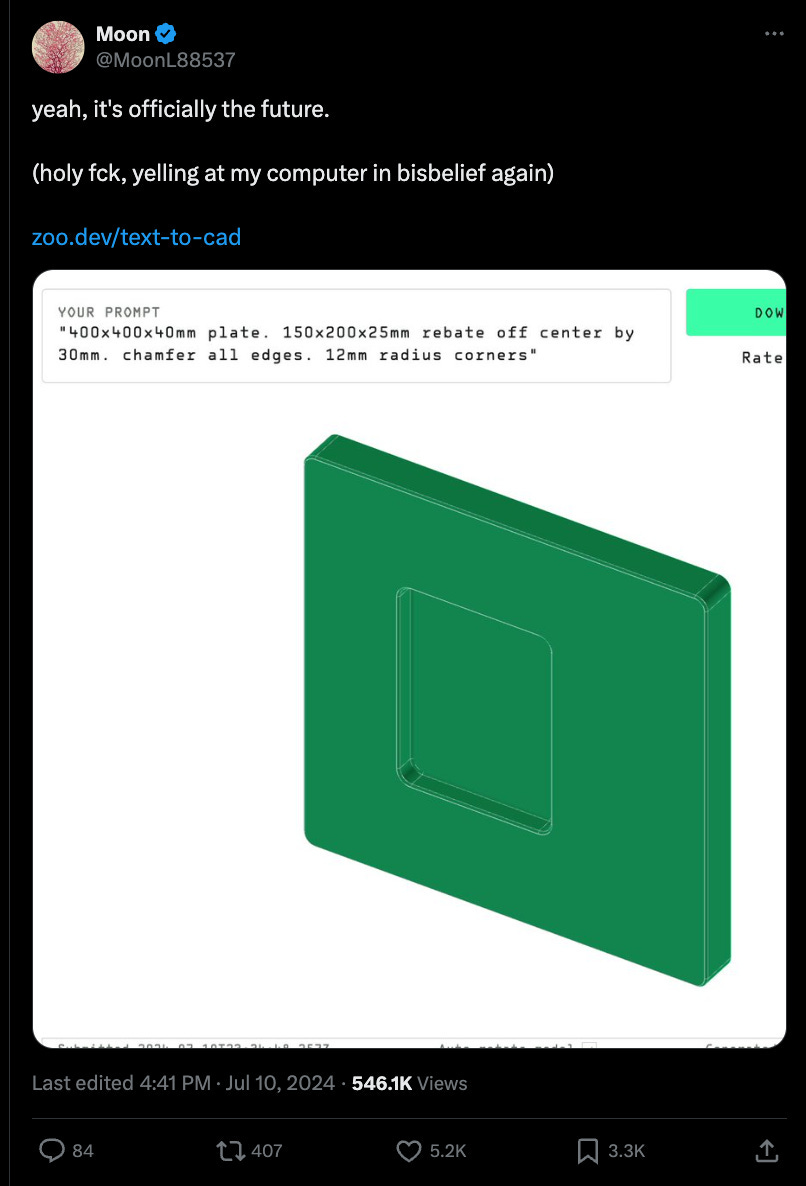Listen → Spotify, YouTube, Apple
Today we have Jordan Noone, Executive Chairman at Zoo and Founding GP of Embedded Ventures. For context, Zoo is a research and infrastructure company building the tools to introduce A.I. to all aspects of hardware development. Previously Jordan Co-Founded Relativity Space at age 22, which was most recently valued at $4.2B.
Jordan dives into:
Why Zoo started by building a novel geometry engine
How the founding team’s background led to Zoo’s products
The impact of generative AI on hardware design
Zoo’s expansion from software for hardware design, to software for the full hardware development cycle
Background on Zoo
Zoo’s mission is to modernize the entire hardware engineering software stack, allowing software-configured hardware design and manufacturing. This involves development ranging from the foundational GPU-level computational geometry algorithm development and implementation, to next-generation GUIs bringing code automation and machine learning to the traditional computer aided design (CAD) process performed by millions of engineers daily, to how those designs turn into the G-code running on the manufacturing equipment creating their designs.
Based in Inglewood, CA Zoo is building these products using their proprietary geometry engine. This engine serves as a digital bridge between hardware development, code, and machine learning frameworks.
Their geometry engine is the world’s first to be GPU based, cloud implemented, API accessible, and dynamically scalable. No one else has this technology, and most think it’s impossible to build. It is fundamental to develop and scale A.I. solutions for hardware development.
In English: It's software to help build hardware easier.
More on Founding Team, Funding, Product, Tools, Infrastructure, Docs, Use Cases & viral tweets below..
Founding Team
Jessie Frazelle, CEO
One of the top infrastructure-as-code developers in the world. Previously she was co-founder and Chief Product Officer of Oxide Computer Company. That experience introduced her to the archaic world of hardware design, which led her to ask Jenna for an introduction to Jordan, which led to the original thesis behind Zoo. She was previously at Docker, was one of it’s top contributors to the project, and personally ran over a dozen of their software releases.
Jordan Noone, Executive Chairman
In 2015 at 22 years old, Jordan started Relativity Space, which was most recently valued at $4.2B, and is the space startup with the most complicated tech in the industry. He was Relativity's CTO for the first five years, Jordan focused on technical direction and engineering design, including: developing the world’s largest metal 3D printers and the world’s first 3D printed rocket. Hardware is in the 2020’s, the software for it is in the 1980’s.
Jenna Bryant, VP of Creative & Talent
Learning computer aided design tools during her degree in fashion design, led Jenna to a tremendously successful career in tech. It began during the rise of Silicon Beach, and working with startups like Oculus, Tinder & Snap in their early days was her norm. She spent a decade building teams with the most in-demand engineers in the world before transitioning into venture capital and founding Embedded Ventures.
Funding to Date
Last raised: $5M Seed
Total Funding: $6M
Investors:
Embedded Ventures (pre-seed lead), Venrex (seed lead), USC’s Viterbi School of Engineering, Gaingels, Undeterred Capital, Tom Preston-Werner’s Family Office, Nat Friedman, Liquid 2, Madrona Venture Group, Bernie Lagrange, Kelvin Beachum, Matt Terrell
How Zoo’s geometry engine unlocks A.I. training
In hardware development, design geometry is the data. Without the ability to talk to the data, there is no ability to train A.I. models. In order to implement A.I. solutions, you need a geometry engine with:
High performance GPU computation
Dynamic scalability in the cloud
Remote access via APIs
Zoo’s geometry engine has all three features, no one else’s has even one of these features.
Products
Infrastructure
Zoo’s APIs are infrastructure for hardware development.
Analogous to OpenAI’s APIs. Targeted at developers building their own products and workflows.
KittyCAD API: Geometry Engine endpoints for software developers
ML-ephant API: Machine Learning endpoints for software developers
Tools
Zoo’s Tools are products built on their own infrastructure.
Analogous to OpenAI’s ChatGPT. Targeted at mechanical engineers who want turnkey solutions. These Tools are majority open-source, drive traffic through Zoo’s APIs, and prime our developer base as they build their own products using our APIs.
Modeling App: Edit CAD visually or with code
Text-To-CAD: Generate CAD from text prompts (soon to be part of the Modeling App!)
Diff Viewer: Visualize CAD changes on Github
Use Cases:
Generative AI for parametric hardware designs, dramatically reducing design labor. Use a text prompt instead of manually defined geometry with a mouse (think ChatGPT but generating a CAD design instead of text).
Creating software-defined workflows to automatically generate and modify hardware designs
Integrating CAD data with other upstream or downstream data systems, such as modifying CAD data based on requirements changes, or modifying manufacturing instructions based on CAD data changes.
Developing custom applications on top of our APIs, similar to how many companies build products on top of Stripe or OpenAI’s API infrastructure.
Tech
For pre-built mechanical engineering solutions, explore their GitHub to see their full suite of open source tools.
For software developers building their own solutions → Check out their Docs
API Reference
Read the full documentation for Zoo's application programming interface.CLI Manual
Read the manual for the Zoo command line interface.Create an API Token
Visit your account page to create a token, the first thing you need to start building with Zoo's APIs.Install a client
We support clients for TypeScript, Python, Go, and Rust, as well as basic cURL. Install Zoo's sdk in your lingua franca.Convert a CAD file with JavaScript
Follow this tutorial to get your first experience working with the Zoo TypeScript client.Convert a CAD file with Python
This is the same tutorial for our snake_case_loving developers out there.
Viral Demand
With customer posts getting over 546K views, 5.2K likes, 3.3K bookmarks, Text-to-CAD is generating meaningful buzz and usage given the demand for Zoo’s unique products.






Wonderful summary of our work!